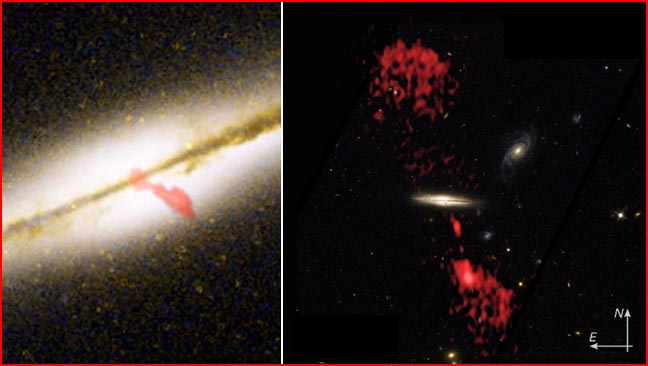
home •
about •
essential guide •
picture of the day •
thunderblogs •
news •
multimedia •
predictions •
products •
get involved •
contact
picture of the day archive subject index
Two views of Galaxy 0313-192, both involving radio images from the Very Large Array
superimposed on images recorded by the Hubble Space Telescope.
Credit: NASA, NRAO, AUI/NSF/ACS/WFC, W. Keel (University of Alabama), M. Ledlow (Gemini Observatory), F. Owen (NRAO) and AUI/NSF
Mar 28, 2007
A Radio Message from SpaceAstronomers were perplexed when they found that a “radio galaxy” revealed a structure that such radio sources were never supposed to take: it is a spiral galaxy. The radio signals confirm that the galaxy’s spiraling structure is embedded in vastly larger electric circuits.
Pictured above are images of the Radio Galaxy 0313-192 (close-up on left), labeled “a giant radio source from the wrong kind of galaxy”—a spiral. For many years it has been assumed that spiral galaxies do not emit the kinds of jets and associated radio signals recorded in the wide-angle view (right). Of course we can only view the galaxy edge-on. But by analyzing the vertical structure of the dust and “blue star forming regions” close to the plane of the galaxy, astronomers were able to confirm that it is in fact a spiral.
The radio images were taken with the Very Large Array (VLA) at a wavelength of 20 centimeters, and the pictures above superimpose these on Hubble Space Telescope images of the same galaxy, showing the relationship of radio emissions to the rotational axis of the galaxy. Jets of charged particles are moving in opposite directions close to the rotational axis, at velocities approaching the speed of light.
Electrons moving at such velocities emit “synchrotron” radiation, characterized by a frequency significantly higher than the usual radiation of electrons in plasma. This is the radiation that our radio telescopes (such as the VLA) detect as the energetic signature of events not seen in the electromagnetic spectrum of visible light. They are direct witnesses to electric currents on a galactic scale.
Synchrotron radiation was first brought to the attention of astronomers by Hannes Alfvén and Nicolai Herlofson in 1950—a remarkable fact considering that, at the time, plasma and magnetic fields were thought to have little, if anything, to do with the “island universes” of remote galaxies.
Decades later, when synchrotron radiation could not be denied, it began to enter the lexicon of astronomy. So there were attempts to simulate synchrotron radiation using only gravity and magnetic fields. But Alfvén had already come to realize that magnetism alone is not sufficient. Causative electric fields and currents are essential. The simulations failed.
Nevertheless, the astronomers’ attempts to get by without electricity have continued. Here is the description of the standard view of polar jets, as given in a Hubble news release on Radio Galaxy 0313-192: “Astronomers believe such jets originate at the cores of galaxies, where supermassive black holes provide the tremendous gravitational energy to accelerate particles to nearly the speed of light. Magnetic fields twisted tightly by spinning disks of material being sucked into the black hole are presumed to narrow the speeding particles into thin jets, like a nozzle on a garden hose”.
There is something about the simplified language of news releases that puts an exclamation point to the contradictions faced by a failing theoretical framework. How is it that the “tremendous gravitational energy” accelerates particles away from a galaxy? (“It means that if you push on your wagon hard enough, it will go in the opposite direction,” says one skeptic). Trying to drive such a system with gravitational dynamics alone, calling upon magnetic fields but ignoring the electric currents that are necessary to sustain magnetic fields, then resorting to the analogy of a “nozzle on a garden hose”, can only add to the exasperation of critics. Plasma cosmologists, together with such electrical theorists as Wallace Thornhill and Don Scott, wonder aloud why anyone would cling to a gravity-only, electrically sterile universe so tenaciously. After all, the galaxy under consideration is distinguished by the presence of gravity-defying jets, emitting radiation that would not be there in the absence electric currents.
While astronomers marvel at the mysterious force that “holds the jets together”, the electrical theorists remind us that the jets are self-confining Birkeland currents in the plasma environment of the galaxy. It is in the nature of Birkeland currents to induce magnetic fields, confining the jets’ to narrow paths over cosmic distances.
Since the attempts to “hold together” such jets experimentally—without electricity—have already failed, it is surely time for astronomers to re-examine their premises.
![]()
home •
thunderblogs •
forum •
picture of the day •
resources •
team •
updates •
contact us
EXECUTIVE EDITORS:
David Talbott, Wallace Thornhill
MANAGING EDITORS:
Steve Smith, Mel Acheson
CONTRIBUTING EDITORS: Michael Armstrong, Dwardu Cardona,
Ev Cochrane,
C.J. Ransom, Don Scott, Rens van der Sluijs, Ian Tresman
WEBMASTER: Brian Talbott
Copyright 2007: thunderbolts.info
